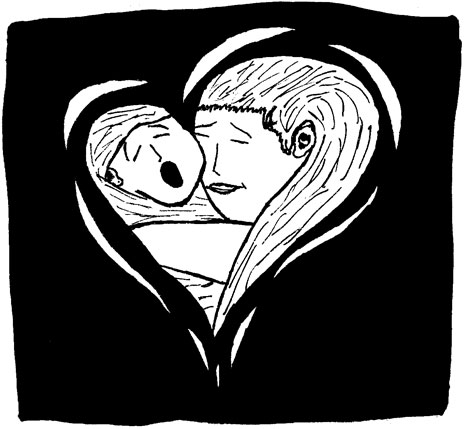
art by Amir Soliman
My son was taken from me straight from the hospital because he was born positive tox. At first, I saw him weekly with my older daughter, who was 7. I would whisper in his ear, “Mommy loves you, and you’re coming home soon.” He was so little I had to give him something that would help him connect to me.
But I felt very disconnected. So three times I asked for “bonding visits”—which are twice a week—until I finally got a court order to make them happen. Then I would bring special treats for him and we’d have our Mommy Time.
I think it helped, because when he came home after 11 months, I would pick him up and gently whisper, “You’re home now. Mommy loves you.” He would light up.
Still, it’s very hard to bond when your baby is in foster care. To find out how parents can connect with their babies, I talked with Mary Dozier, a professor at the University of Delaware who helps birth parents and foster parents bond with their babies.
Q: What kind of care do babies need to develop strong bonds with their parents?
A: It’s very important to have nurturing, stable care from someone who is very highly committed to the child. The baby needs to know that somebody is going to be there for him and respond to his needs.
Babies are biologically wired to have a caregiver who’s going to be there no matter what. There’s a range of situations that babies can adapt to—like being in childcare, or having a babysitter—but it really challenges babies beyond what they can deal with to have caregivers who are not committed to them or to change from one caregiver to another.
Q: How does it affect babies to move from one caregiver to another?
A: When babies move from one home to another, it’s hard for the baby to trust the new caregiver. We’ve been studying how moves affect babies’ bodies and behavior.
We see that babies who’ve been moved around tend to push away their caregivers or cannot be soothed when they’re upset. Because they push away help, these babies look like they don’t need care, and their caregivers respond by giving them less attention.
If you are a birth parent who is reuniting with your baby, you can be hurt so badly if your baby acts like he doesn’t need you or pushes you away. We do a lot of work with birth parents to help them see it’s not personal. The child had to adapt in this way just to deal with multiple separations. And the good news is that babies’ behavior can change if the parents know how to respond.
Q: How can parents help their babies bond?
A: To help parents bond with their babies, we do a 10-session intervention with the mom and her baby. We try to get them to learn a few things:
First, parents need to very gently provide nurturance and affection even though child doesn’t seem to want it.
It’s hard for the parent not to start to assume, “He doesn’t need me,” or, “I haven’t been with him and he doesn’t care about me anymore.” I know that from personal experience. I was divorced when my kids were 2 and 4, and when my 2-year-old started visiting his dad, he’d come back so mad because I hadn’t been with him. He’d lash out and even hit me.
My normal instinct would be to say, “Don’t do that. You can’t hit me.” But I was studying kids’ development, so one day I said, “I think you’re mad because I wasn’t with you last night.” He said, “That’s why I’m mad!” and we had a real connection. He needed me to recognize how he was feeling.
The second important task is for parents to learn how to nurture their babies. Lots of us as parents are not naturally nurturing, so you have to override your instincts.
Say a child falls and hits his head, and cries. We don’t want parent to just say, “That didn’t hurt!” Instead, the parent can gently pat the baby’s back and say, “Oh, honey, that hurts, doesn’t it?” We videotape the moms with their babies and then review the videos with them. We help them see what their automatic response is and begin to make different kinds of responses.
The third thing we help parents learn is to follow the baby’s lead and create a warm, delighted relationship with their child.
Suppose that a mom isn’t showing a lot of excitement in taking care of her baby. We use the videotapes to help the mom see when she and her baby are connecting and when they’re not. So you might see the child throwing a toy on the floor and Mom not giving it back or smiling. Well, the mom might not realize it’s a game, and that the baby’s showing her that he’s so excited and engaged.
If every once in a while you see Mom smiling at her child, then we really focus on his response and say, “He just lights up when you do that.” Often, moms are able to say, “I didn’t do it there, and look how he got sad.”
It isn’t easy, but in using this method with foster parents, we’ve been able to prove that we improve how secure the babies feel.
Q: What are some signs that parents and their babies might need extra help reconnecting?
A: One sign is that someone says, “Oh, this child is just doing great. He’s not upset by the move at all. He never cries, he doesn’t ask anything of me.” You don’t want a child that doesn’t show distress at all. You want him to trust in his caregiver to help him with his distress. If the child has pulled into himself and does not depend on anybody, I would worry about that.
I always tell parents, “Babies shouldn’t be easy.” It’s not that they shouldn’t be pleasant and happy, but a baby who’s willing to sit in a carrier for hours is not doing well. The baby should be crawling on adults. We really want babies that ask a lot of their worlds.
